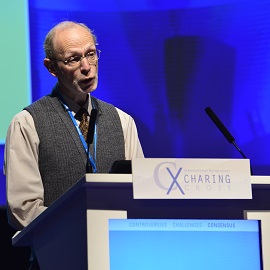
First-time data presentation from the SWAN (Screening Women for Abdominal aNeurysms) project was heard at CX yesterday. The study, which used simulation to evaluate whether inviting women to be screened for abdominal aortic aneurysm would have clinical benefit, or be cost-effective, revealed that such a programme would yield a very small benefit. Further, such a screening programme would not be cost-effective in the UK context.
“We did not find any combination of screening options for women that would make population-based abdominal aortic aneurysm screening cost-effective,” said Simon Thompson, Cambridge, UK, who presented the data.
The NHS Abdominal Aortic Screening Programme (NAAASP) for men aged 65 was initiated in 2009 to reduce deaths from aneurysm rupture and is now rolled out across the UK. There is no systematic screening for women, since abdominal aortic aneurysm prevalence is substantially lower than in men. Also, elective surgery outcomes are worse. “Whether screening should be extended to women is uncertain and SWAN was undertaken to shed light on whether women should be screened.”
Modelling of NAAASP showed that the programme for men would be cost-effective down to an aneurysm prevalence of 0.35%. Also, a third of deaths from abdominal aortic aneurysm in the UK are now in women.
The investigators in the project developed a clinically realistic simulation model of screening, surveillance, and elective and emergency abdominal aortic repair operations. They employed input parameters specifically for women and the model was run for 10 million women, with parameter uncertainty addressed by probabilistic and deterministic sensitivity analyses with settings specific to population screening in the UK. The participant base case settings were for women aged 65 years, followed up to age 95 who were invited to ultrasound screening, followed by surveillance for small abdominal aortic aneurysm, and elective repair for large abdominal aortic aneurysm.
The main outcome measures of the project were the number of operations undertaken; aneurysm-related mortality; quality-adjusted life-years, NHS costs and cost-effectiveness with annual discounting. Data were obtained from a variety of sources including the RESCAN surveillance data; National Vascular Registry (NVR); Hospital Episode Statistics (HES); EVAR-1 trial of elective surgery; and the IMPROVE trial of emergency surgery.
The base-case results for women showed that following invitation to screening, elective operations would rise by 21%; emergency operations would fall by 6% and deaths from abdominal aortic aneurysm would go down by 4%. Further, per 100,000 women invited to screening, there would be 207 years-of-life gained and £3.54m additional costs. The cost-effectiveness was calculated as £45,000 per quality-adjusted life-year (QALY) gained, and the UK guideline for acceptance in the NHS is <£20,000 per QALY.
“In the absence of randomised trial data, detailed modelling is the best approach. However, some parameters are very uncertain in women and poorly estimated, potentially lacking relevance or are unavailable for women,” Thompson said while discussing the limitations of the study.







